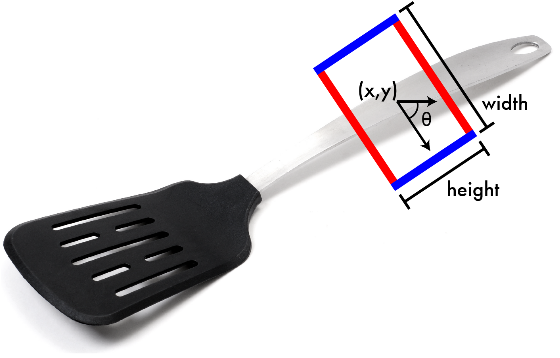tnikolla / Robot Grasp Detection
Programming Languages
Projects that are alternatives of or similar to Robot Grasp Detection
Detecting grasping positions with deep neural networks using RGB images
(The model is uploaded but you can train better yourself if you have the time and the machine or if you are learning Tensorflow/ML. Please bear in mind that you need to read and adapt to your needs some parts of the code. Feel free to open an issue if you need help. I will try to update README and comment the code.)
This implementation is mainly based on the algorithm from Redmon and Angelova described in arXiv:1412.3128v2.
The method uses an RGB image to find a single grasp. A deep convolutional neural network is applied to an image of an ohject and as a result one gets the coordinates, dimensions, and orientation of one possible grasp.
The images used to train the network are from Cornell Grasping Dataset.
Problem description
Having in mind a parallel plate griper before it closes, a simple and natural way of picturing the grasping position in an image would be a rectangle (see figure 1).
One way representing it uniquely is as
g = {x, y, \theta, h, w}
where (x,y) is the center of the rectangle, \theta is the orientation of the rectangle to the horizontal axis of the image, h and w are the dimensions (height and width) of the rectangle.
The sole purpose of this small library is to train a network that given a RGB image is able (with some accuracy) to predict a possible grasp g.
How to train from scratch
The procedure follows these steps:
- convert ImageNet in TFRecord format
- train the model on ImageNet
- convert the grasping dataset in TFRecords
- train on the grasping dataset using the pretrained weights
Prepering Imagenet
Before running the script you will need to download and convert the ImageNet data to native TFRecord format. Check this link from the Inception model from Google. I found the whole Inception model in Github very useful.
Training on Imagenet
Running imagenet_classifier.py will do the trick. But first change the default dataset directory (mine lies in /root/imagenet-data)
Check also in the end of the file the options that you can use, for example:
./imagenet_classifier.py --batch_size=128 --model_path=./models/imagenet/m1/m1.ckpt --train_or_validation=train
Running on a GTX 980 and a very^2 good Xeon it needs around two days (I didn't time it). Check in the begining if the model is saving/restoring the weights.
Prepering Cornell grasping dataset
After downloading and decompressing run build_cgd_dataset.py. Make sure to adapt to your needs the python file, for example
- point
datasetin the right place - in
filename[:49]adapt the number 49 (you can contribute, or I will program it better someday)
Train on grasping dataset
Just run grasp_det.py for the training, or give some arguments as in training Imagenet. These are just around 1000 examples (images with grasps) and can be trained very fast. Careful not to overfit.

